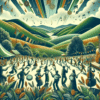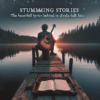Folk Revival: Celebrating the New Wave of Indie Folk Artists

The folk music genre has undergone several transformations since its inception, reflecting the social and cultural dynamics of their times. Today, we witness a Folk Revival movement, fueled by a new generation of indie artists who are breathing fresh life into traditional sounds. This article will explore the essence of this revival, the artists at the forefront, and the cultural significance of the indie folk genre in contemporary society.
Historical Context of Folk Music
Folk music, rooted in oral traditions, serves as a cultural archive, preserving the stories, struggles, and aspirations of diverse communities. Historically, it has echoed the sentiments of the working class, offering a voice for social injustices and personal narratives. The folk revival of the 1950s and 1960s, led by artists like Joan Baez and Bob Dylan, reignited public interest in these timeless traditions, paving the way for contemporary expectants.
Through the years, folk music has maintained its relevance by adapting to changing musical landscapes. Today, this evolution manifests in the indie folk movement, which interweaves traditional styles with contemporary influences, creating a sound that is familiar yet fresh.
The New Wave of Indie Folk Artists
Embracing Individuality and Authenticity
See Also: Harmony in the Hills: A Guide to the Best Folk Music Festivals of 2023
Harmony in the Hills: A Guide to the Best Folk Music Festivals of 2023At the heart of the current folk revival is a new wave of indie artists who prioritize individuality and authenticity. This movement is characterized by a diverse array of sounds that draw from various influences, ranging from bluegrass to alternative rock. Artists like Phoebe Bridgers, Sufjan Stevens, and Hozier have emerged as notable figures in this landscape, fusing their personal narratives with folk elements to craft original melodies.
Women Leading the Charge
Women are playing a pivotal role in the revival of folk music. Artists such as Brandi Carlile, Florence Welch (of Florence + The Machine), and Joni Mitchell, who is experiencing a renaissance in popularity, are redefining folk through their powerful lyrics and emotive performances. Their music resonates with listeners on multiple levels, addressing themes of love, identity, and empowerment.
Collaboration Across Genres
A defining feature of this folk revival is the seamless crossover between genres. Indie folk often incorporates elements from pop, rock, and even electronic music. This blending creates a rich tapestry of sounds that appeals to a wider audience. For instance, the collaboration between folk artists and hip-hop musicians showcases the fluidity of the genre, dismantling the notion of boundaries in contemporary music culture.
Grassroots Movements and DIY Ethos
The indie folk scene is largely DIY, promoting a grassroots approach to music production and distribution. Many artists are using platforms like Bandcamp and SoundCloud to share their work, connecting with audiences directly without the constraints of major label systems. This democratization of music has created an environment where indie folk can thrive, as artists focus on their craft and build genuine connections with their fans.
See Also: “Voice of the People: Exploring the Stories Behind Traditional Folk Songs”
“Voice of the People: Exploring the Stories Behind Traditional Folk Songs”Thematic Exploration in Indie Folk
Storytelling and Personal Narrative
At its core, folk music is storytelling. The current wave of indie folk artists emphasizes this tradition by integrating personal narratives into their songs. Their lyrics often explore themes of nostalgia, mental health, and social awareness, resonating deeply with listeners. For instance, Bridgers’ poignant lyrics offer insight into her struggles, while Hozier's songs often intertwine personal and societal themes.
Environmentalism and Social Justice
Today’s indie folk artists are also using their platforms to advocate for important causes, aligning with the historical roots of folk music as a vehicle for social change. Many artists are vocal about environmentalism, racial justice, and mental health issues, reminding audiences of the genre’s original purpose.
Cultural Heritage and Ethnic Influences
The new wave of folk artists is not solely rooted in Western traditions. Many are drawing from their cultural heritage to create music that reflects their identities. This blend of ethnic influences enriches the genre, allowing it to evolve while remaining true to its roots.
See Also: From Coffee Shops to Festivals: The Journey of Indie Folk Musicians
From Coffee Shops to Festivals: The Journey of Indie Folk MusiciansThe Importance of the Folk Revival Movement
The current folk revival is significant for several reasons:
Preservation of Culture
Indie folk artists play an essential role in preserving the storytelling traditions of their communities. By drawing on folklore and heritage, they ensure that cultural narratives are not lost to time. This preservation fosters a sense of belonging and shared identity among listeners.
Cross-Generational Appeal
The revival has brought together listeners across generations. Older generations may find comfort and nostalgia in the sounds reminiscent of traditional folk music, while younger audiences are drawn to the relatability and contemporary relevance of the lyrical themes.
See Also: The Rise of Indie Folk: How a Genre Redefined Acoustic Sounds
The Rise of Indie Folk: How a Genre Redefined Acoustic SoundsMental Health Discourse
Indie folk's candid exploration of mental health issues has paved the way for essential discussions surrounding emotional well-being. Artists openly sharing their struggles help destigmatize mental health challenges, encouraging listeners to seek help and express their feelings.
Conclusion
In conclusion, the Folk Revival represented by the new wave of indie artists showcases the timeless nature of this genre. By embracing individuality, blending diverse influences, and advocating for social causes, these artists are ensuring that folk music remains relevant in today’s rapidly changing cultural landscape. As long as there are stories to tell and emotions to explore, folk music will continue to thrive, connecting generations and communities in profound ways.
FAQs
What is Indie Folk Music?
Indie folk music is a contemporary genre that blends traditional folk elements with other influences, such as rock, pop, and electronic. Indie folk artists typically emphasize personal storytelling in their lyrics.
See Also: Strumming Stories: The Heartfelt Lyrics Behind Indie Folk Hits
Strumming Stories: The Heartfelt Lyrics Behind Indie Folk HitsWho are some notable indie folk artists?
Notable indie folk artists include Phoebe Bridgers, Sufjan Stevens, Hozier, Brandi Carlile, and Florence Welch.
How has the folk revival influenced social causes?
Many indie folk artists use their music to advocate for social causes, such as environmentalism, mental health awareness, and social justice. Their songs often reflect personal experiences related to these issues.
How can I discover new indie folk artists?
You can discover new indie folk artists by exploring platforms like Bandcamp, SoundCloud, and Spotify. Additionally, attending live music events or festivals focused on indie folk can introduce you to new talents.
Is folk music relevant today?
See Also: Harmony in Simplicity: Why Acoustic Folk Music is Making a Resurgence
Harmony in Simplicity: Why Acoustic Folk Music is Making a ResurgenceAbsolutely! Folk music is more relevant than ever as it continues to evolve, reflecting contemporary themes and issues that resonate with modern audiences. The ongoing revival showcases its enduring power to connect and inspire.
If you want to know other articles similar to Folk Revival: Celebrating the New Wave of Indie Folk Artists you can visit the category Folk.
